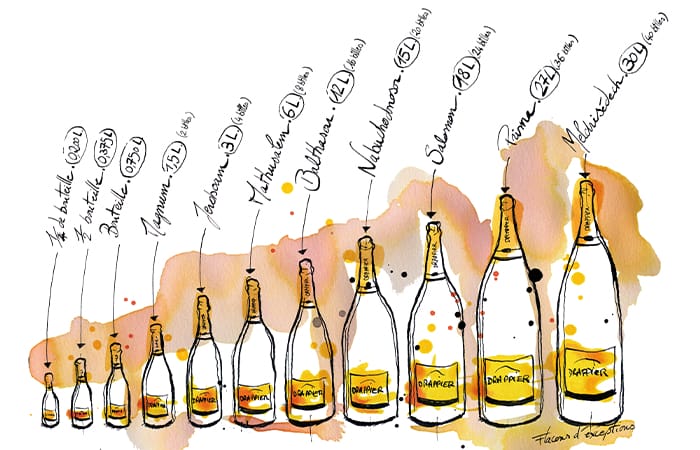
by
Louis Roederer’s chef de cave (chief winemaker) Jean-Baptiste Lecaillon is redefining non-vintage champagne as we know it to meet the challenges of climate change.
The flagship style of the region, non- vintage champagne makes up 90 per cent of the 300 million bottles of champagne sold every year and is characterised by two attributes: a house’s composition is tied to its style, and, until recently, each house did not reveal its non-vintage recipe.
(You may like: Champagne House Louis Roederer Launches its Collection Series)
CHANGING THE GAME
“We created the non-vintage [style] when the fruit was not ripe in the 70s and 80s,” Lecaillon explains. “We had to build the fruitiness and texture with reserve wines since the wines were acidic and not very fruity,” he continues. He compares this process to killing the vintage. “We were doing whatever we could in the cellar to bring ripeness to quite unripe fruit.”
But that was 40 years ago. Since then, Roederer has experienced two significant changes. Lecaillon says, “Our farming has changed dramatically since 1990, and we are going for more sustainable, organic farming and deep-rooted vines.”
The second is riper grapes. As the Champagne region warms up, the harvest has pushed forward by a month, producing riper, healthy, vintage-quality grapes. Take the 2002 vintage, when the grapes were so optimal that Lecaillon had to dial down the vintage character to create a non-vintage wine that would conform to house style. It was time to change things.
THE CHAMPAGNE RESET
In an unprecedented move this year, he retired the 35-year-old bestselling, non- vintage Louis Roederer Brut Premier. Instead, he introduced a bold new formula for non-vintage champagne: a “multi- vintage” champagne called Collection 242.
He emphasises the freshness of the recent vintage instead of masking it with oaked reserve wines. The 2017 vintage, marking the 242nd harvest since the house opened in 1776, comprises 56 per cent of the cuvee. The classic oak reserve wines contribute 10 per cent, and the remaining 34 per cent comes from a new reserve built in recent years that’s called the reserve perpetuelle. In a pioneering move, Lecaillon blends the two reserves, one oxidative and the other reductive, together to add layers to the cuvee.
The recipe is a deliberate departure from the ‘consistent house style’ philosophy, and an equally willful attempt at creating an expression of the vintage. As Lecaillon states, “Our ambition in this wine is not to do a consistent taste year after year. It is to make vintage-level wines.”
Roederer is not the first to espouse a vintage-based cuvee. Jacquesson and Krug walked this path before him. Dizy-based Jacquesson switched to a numbered series in 2000 and changes the formula each year to celebrate the vintage variance and terroir. Krug launched the multi-vintage Grand Cuvee in 2015 with the same philosophy of celebrating vintage variances instead of guarding the base vintages under a shroud of secrecy.
Lecaillon’s bold move is winning him plaudits. As Caroline Henry, author of Terroir Champagne states: “Roederer joins the small selection of ‘star’ growers who already identify the base vintage on the back label. We are talking about maybe 1 per cent of the total champagne production.”
(You may like: Moët & Chandon Unites Us With Champagne This Holiday Season)
CELEBRATING TRANSPARENCY
This small percentage is pushing boundaries, partly because of public interest. “Today’s consumers are more educated on wines and champagne. They want to know how their wine is made,” Lecaillon shares.
To serve these consumers, Krug has created the Krug iD, a six-digit number that can be scanned on the back of every bottle. Chef de cave Julie Cavil explains, “The Krug iD provides a detailed explanation of the Krug bottle, its composition, my impressions of the year, and food pairing inspiration. It also provides recommendations on how to store and serve the bottle.”
The front label of grower champagne Telmont tells the whole story. CEO Ludovic du Plessis cites transparency as one of his core values, inspired by the whisky industry’s specific labelling standards. “My wine’s label is its ID,” he says. “I wanted everything on the front of the bottle, not just the back.”
There is a QR code on the back of the bottle with provenance details, down to the percentages, years blended, and the disgorgement date, to satisfy the oenophile’s curiosity.
A DEEP-ROOTED COMMITMENT
Author Henry finds that “the biggest efforts of the Champagne region to fight climate change have been focused on reducing the carbon footprint, which it has reduced significantly over the last 20 years”.
When it comes to Roederer, Lecaillon realised organic grapes are lower in pH, contributing to their freshness. Cristal is now exclusively sourced from organic vineyard plots, but some grapes for the collection series are purchased from contract growers, so Lecaillon is spreading organic awareness throughout the region.
“We visit the growers, we choose the plots, we visit the grapes during the season, we discuss [organic] farming with the growers, and we set the date of harvest, which is important and rare.” This is all part of the unique new contract Roederer has signed with his growers.
Despite these forward-looking producers, champagne is only 3 per cent organic. Bordeaux and Burgundy, on the other hand, claim organic conversions of about 25 per cent. Considering the region’s marginal weather, rain, and disease, going organic is a commendable decision. all part of the unique new contract Roederer has signed with his growers.



